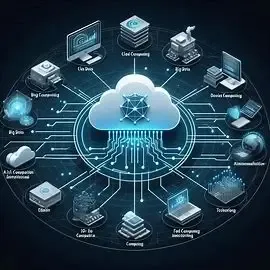Cloud Computing Technologies
Big Data, AI, IoT, Edge, and Fog Computing
Introduction
Cloud computing acts as an enabler for emerging technologies, providing the scalable infrastructure and services required for Big Data, Artificial Intelligence (AI), Internet of Things (IoT), Edge, and Fog computing.
1. Big Data and Cloud Computing
- Cloud provides storage and computing power for processing massive datasets.
- Supports Big Data tools like Hadoop, Spark, and data lakes in the cloud.
2. AI and Cloud Computing
- Cloud AI platforms offer machine learning models, APIs, and services.
- Enables businesses to build intelligent applications without complex infrastructure.
3. IoT and Cloud Computing
- Cloud enables IoT devices to send, store, and analyze data centrally.
- Supports real-time data analytics, device management, and security.
4. Edge Computing
- Processes data closer to the source (devices, sensors) to reduce latency and bandwidth.
- Used in time-sensitive applications like autonomous vehicles, healthcare, and smart cities.
5. Fog Computing
- Extends cloud to the network edge by adding an intermediate layer (fog nodes).
- Enhances performance, security, and real-time processing.
Conclusion
The integration of cloud computing with these technologies accelerates digital transformation, driving innovation, efficiency, and new business models across industries.

Figure 11. Cloud Computing connecting with other AI Technologies
👉 Discover how cloud computing architecture supports these advanced technologies:
Explore Cloud Computing Architecture
✅ SHARE




Comments
Post a Comment